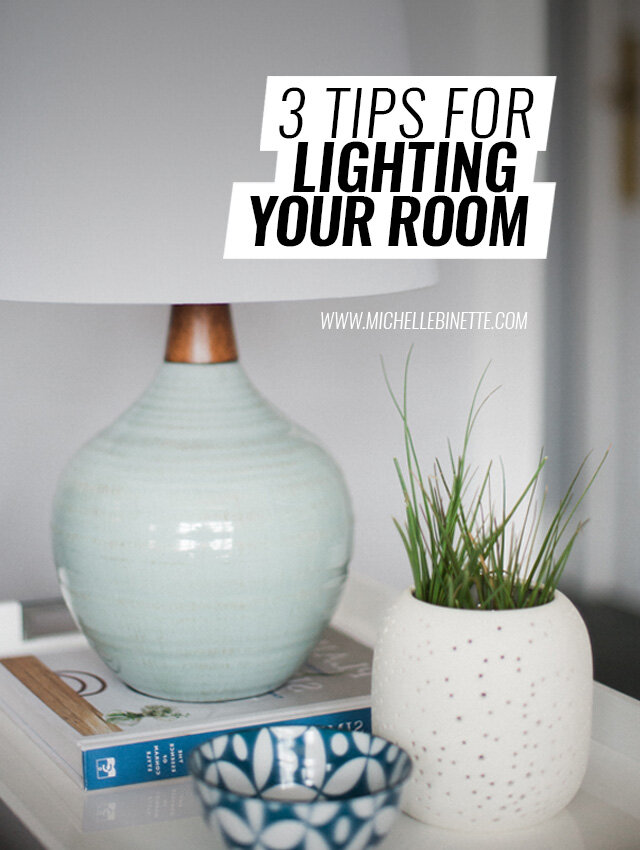3 Tips for Lighting your Room
 Lighting. It seems so simple, I mean, how hard can it be? Throw a light fixture up and flick the the switch. Right?Not right.Lighting is one of the most overlooked elements when decorating a room. People tend to rely on one lighting source, and it's often the overhead light which is incredible unflattering. If I told you that adding more light into your space would help you look better, would you do it?I thought you'd say yes.Check out this Dream Homies TV episode for my three quick tips to create a beautifully lit room. Keep reading after the video for a more in depth overview.See that face up there, I bet that was the face you made when you heard some of my tips! Not to worry, it's all manageable, I promise. If you want your space to have a designer-feel, then keep reading, cause I've got more deets on how to make it happen.
Lighting. It seems so simple, I mean, how hard can it be? Throw a light fixture up and flick the the switch. Right?Not right.Lighting is one of the most overlooked elements when decorating a room. People tend to rely on one lighting source, and it's often the overhead light which is incredible unflattering. If I told you that adding more light into your space would help you look better, would you do it?I thought you'd say yes.Check out this Dream Homies TV episode for my three quick tips to create a beautifully lit room. Keep reading after the video for a more in depth overview.See that face up there, I bet that was the face you made when you heard some of my tips! Not to worry, it's all manageable, I promise. If you want your space to have a designer-feel, then keep reading, cause I've got more deets on how to make it happen.
1. Understand the functionality of your space.
This isn't the first time I've said this. Won't be the last. But good design starts with an understanding how you use or how want to use your space. Think about the activities you'll be doing in each room and ensure it's lit appropriately for each. Here's some help on things to consider for each room.
Kitchen Lighting: So many activities that take place in the kitchen; preparing food, eating food and even work (guilty as charged!). Recessed lights (aka pot lights) are a great option in the kitchen, be sure to place them on the sides of ceilings to avoid shadows (that unflattering light I talked about in the video). Keep in mind that recessed lights shouldn't be your only source of light. Your kitchen counters should also be well lit, consider installing lights underneath the cupboards to illuminate your prep space. Islands can also benefit from additional lighting with pendant lights, which can also serve as decorative lighting.Living Room Lighting: The living room is often the heart of your home. You entertain guests, watch movies, read or play games with family (Pictionary anyone?)! In this space you'll want a variety of light (see tip 2 for different types of lighting). Think about where you read or whether there is art you want to showcase with accent lighting.Dining Room Lighting: The dining room is where the family comes together, where you entertain friends and family, and quite often where you'll do task-related things like work. It should have the option for bright light and dim light. You'll want an overhead light, and you can also incorporate recessed lighting. I recommend incorporating a light fixture even if you have recessed lighting, it can create a beautiful statement and focal point in the room and layer light beautifully.Bathroom Lighting: Bathrooms are where we put on make-up, brush our hair and teeth, and in general look at ourselves in the mirror. This is the last place you want unflattering light! Amiright? Whenever possible, opt for lighting on either side of your mirror to help avoid casting unflattering shadows on your face. Recessed lighting is great in a bathroom so long as it's not the only light source. Showers and baths should have a light above them as well.Bedroom Lighting: Sure, the bedroom is primarily for sleeping, but if you're like me it's also a place your read, work and admittedly...watch tv. Light in the bedroom doesn't need to be super bright, but key lighting is helpful. Table lamps on either side of the bed will help with things like reading, and can also help "set the mood". ;)Home Office Lighting: More and more people are working from home, and if you're working from home you know how important it is to have a space that energizes, motivates and keeps you productive. Recessed lights can be a great option, but consider your computer monitor and ensure your light doesn't cast a reflection on your screen. A desk task lamp is important here to help you when writing, reading or sketching. Depending on your job, you might have some achievements to hang on the wall. Art if you're an artist, diplomas, or maybe just an inspiring piece. Consider accent lighting to help create draw attention to the peice or create a focal point.The key is to consider everything you want to do in the space, and ensure the lighting you select helps facilitate that, and having it look good never hurts.
2. Incorporate at least 3 light sources in your room.
This is a doozy isn't it. Most people stop at recessed lights or the overhead light. I get it, most overhead lights are on dimmers, you can blast the light or dim it to the perfect romantic vibe (wow, I got romance on the brain don't I?).The thing is, is all well-designed spaces incorporate different types of light. Combining all types of light gives greater functionality, interest, and the likelihood that you will have sufficient lighting. Like everything there are exceptions to every rule, in general though, use this as a rule of thumb and do your best to incorporate three sources when it makes sense.There are four basic types of lighting that you can consider to get three light sources in your space; ambient lighting, task lighting, accent lighting, and decorative lighting.
Ambient lighting: Provides overall illumination and is often on the ceiling. It's really general lighting for walking around, conversing, and identifying objects.Task lighting: Provides higher, more concentrated lighting for tasks such as chopping vegetables, shaving, or reading.Accent lighting: This is similar to task lighting but is used to focus attention, on things like artwork or architecture.Decorative lighting: This can be any of these three types, but it also brings attention to itself and might even be the focal point of the room, like a chandelier. The important thing to remember is to not select lighting only based on how it looks, performance is important and function should not be compromised for form.
3. Get your lights on dimmers!
If I had my way, every light in my home would be on a dimmer. Dimming helps control your light output to facilitate whatever activity is happening at the time. If you're entertaining you can dim the light for ambience, if you're scrapbooking (not that you'll ever catch me scrapbooking) you can crank the light to the max output for maximum visibility. Plus, by controlling the light output you can actually help save energy! I am never mad at the idea of saving energy.I recommend switching to dimmers in the most important spaces first, for example your living room and dining rooms. Work with a professional to update your switches and be sure to use dimmer light bulbs.


